The Mississippi River is 2,340 miles long and touches ten states, from Minnesota to Louisiana. With this extensive range, it’s no wonder there are multiple habitats along its route, from upland and lowland forests to savannas and prairies. Many mammals live in or near its water. They stick close to rivers because they provide their three basic necessities: food, water, and shelter. Meet ten mammals of the Mississippi River, learn how to identify them, and discover their habitats.
North American River Otter
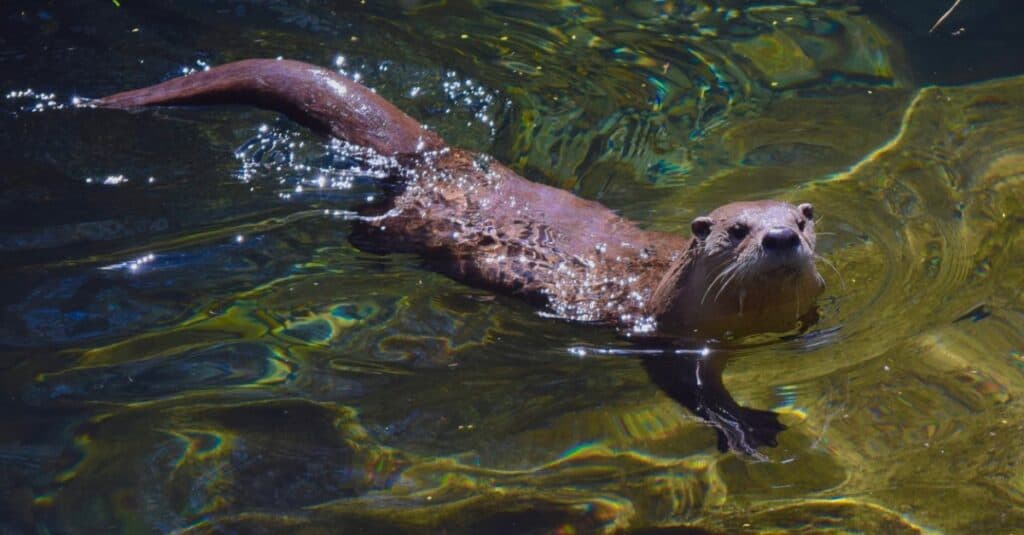
River otters
thrive in river systems, where they make their burrows near the water’s edge.
©iStock.com/Kathryn Farley
The river otter spends most of its time in the water and thrives in river systems, making their burrows near the water’s edge. They build a multitude of tunnels in their home where they can quickly come and go from the water. They have powerful tails, long bodies, water-resistant fur, and webbed feet to help them survive in the water. The otter can also hold its breath for up to eight minutes. River otters can be either diurnal or nocturnal, but they prefer to hunt at night. Their preference is fish, but they will eat anything they can find, such as turtles and crayfish.
Southern Red-Backed Vole
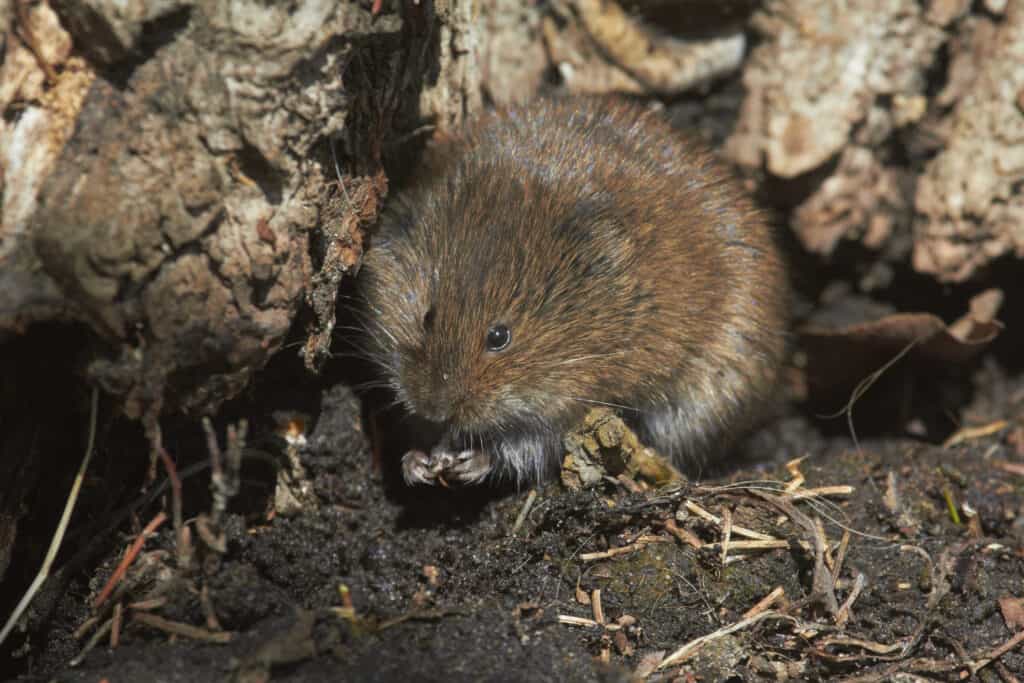
Red-backed voles prefer moist forest habitats.
©iStock.com/ironman100
This vole is slender with round ears and long reddish-brown fur. This rodent is often mistaken for a mouse but is actually related to lemmings and hamsters. The Southern red-backed vole inhabits many terrestrial habitats but prefers to live in moist forests, especially coniferous-deciduous. It thrives anywhere it can access logs, stumps, and roots next to water and food sources. This vole will eat invertebrates but is primarily an herbivore and likes to feast on vegetation and fungi. The red-backed vole is pretty agile and can hop, run, swim, and climb.
Masked Shrew

Masked
shrews
inhabit humid areas with abundant vegetation.
©iStock.com/CreativeNature_nl
The masked shrew is a grayish-brown color with a pointed snout and a long tail. It is the most widely distributed shrew in North America and lives in many Northern United States and Canadian habitats. While this mammal inhabits arid grasslands and tundra, it prefers humid areas with abundant vegetation. Rivers are the perfect habitat for the masked shrew as moisture determines its population prosperity. It nests in decaying logs, stumps, tunnels, or burrows from other animals. Insects comprise most of its diet, but it occasionally dines on small animals like birds and salamanders.
American Mink
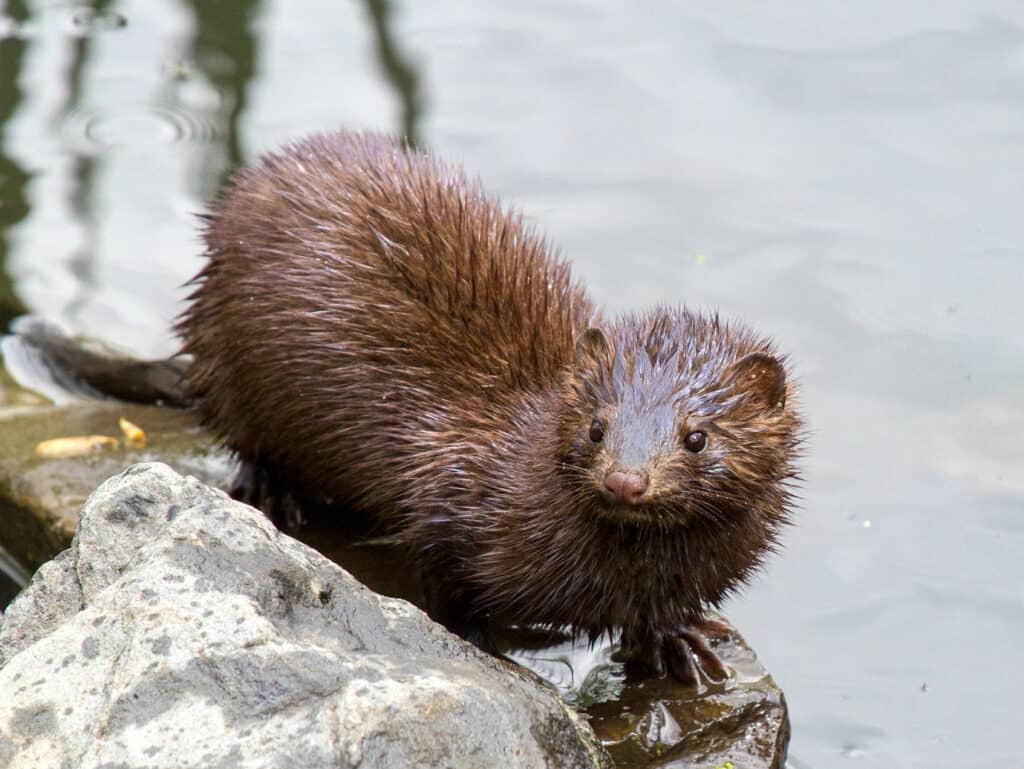
Minks
inhabit areas next to rivers with dense foliage.
©Needsmoreritalin / CC BY-SA 3.0 – License
The American mink is part of the weasel family and is native to North America. This semi-aquatic species is distinguishable by its dark brown or black fur with a white patch on its chin. They also have short legs, long bodies, and webbed feet. The mink is associated with water and inhabits areas next to rivers, streams, swamps, and marshes with dense vegetation. They are skilled climbers and swimmers and are most active at night when they search for food. They dig their burrows in river banks, which they line with fur from their prey. These minks are carnivores and have a diverse diet of frogs, crayfish, small mammals, and birds.
Muskrat

Muskrats
spend most of their time in the water and create burrows near rivers.
©Sergey Uryadnikov/Shutterstock.com
The muskrat is a semi-aquatic rodent with thick, dark brown fur and scaly tails and is the heaviest member of the Cricetidae family (which includes voles, lemmings, and mice). This species is often mistaken for rats and beavers due to its generic appearance and omnivorous diet, but they are not closely related to either. They spend most of their time in the water and can hold their breath for up to 17 minutes. Muskrats create burrows on the rider’s edge, complete with an underwater entrance, where they live in families (mom, dad, and babies).
American Beaver
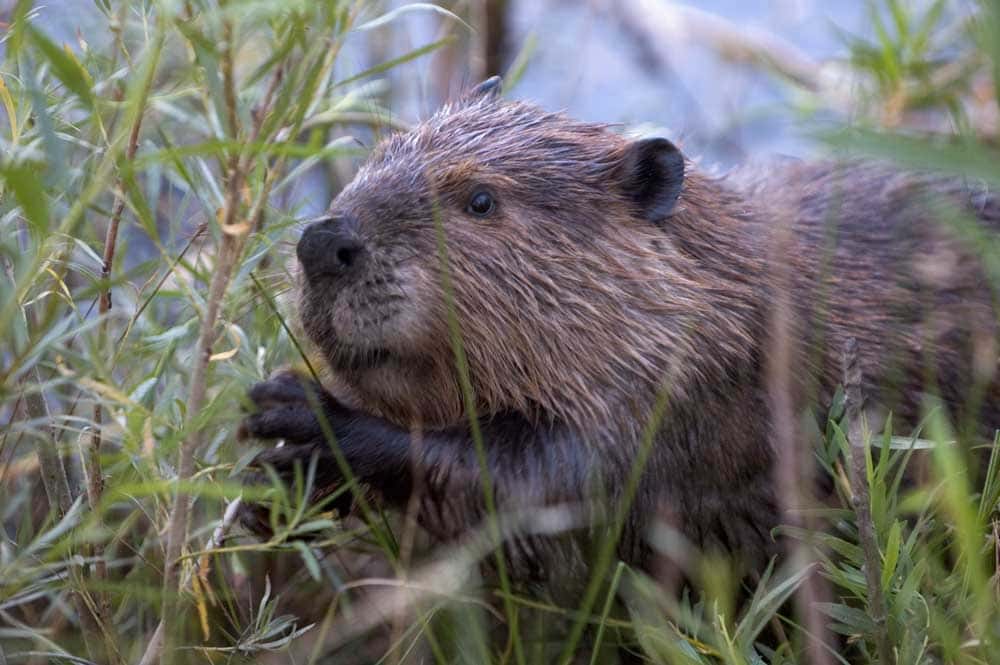
Beavers are semi-aquatic and build dams in rivers.
©No machine-readable author provided. Cszmurlo assumed (based on copyright claims), CC BY-SA 3.0, via Wikimedia Commons – License
The American beaver is the largest rodent in the United States and is native to North America, with fossils dating back seven million years ago. This rodent has a long, flat, black tail, dark-brown fur, webbed feet, and long, thick teeth (which never stop growing). These semi-aquatic herbivores forage for tree bark and plants. They live in rivers and streams throughout the United States, building dams and homes out of branches and mud with underwater entrances. They are one of the few animals that can change the ecosystem by blocking the flow of water.
Virginia Opossum

The Virginia
opossum
inhabits woodlands next to a water source.
©iStock.com/randimal
Also known as the North American opossum, it is the northernmost marsupial in the world. This species varies in size, with North American possums weighing 20 times as much as those from the tropics. They have grayish-brown fur with white faces and long, hairless tails. Opossums are curious creatures with opposable thumbs on their back feet and the ability to “play dead” when they feel threatened. They will inhabit many habitats, but their favorite is woodlands next to a water source. These omnivores are opportunistic and eat whatever they can find, including plants, small mammals, birds, and invertebrates. They also can’t resist roadkill, which is how they become it themselves.
Striped Skunk
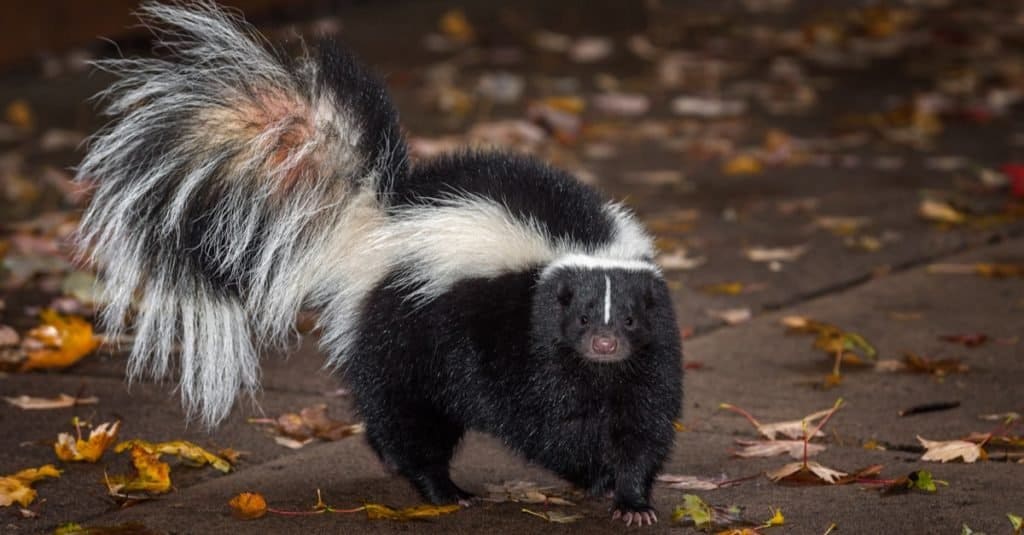
Striped
skunks
live in many habitats but must be near water and food.
©Geoffrey Kuchera/Shutterstock.com
The striped skunk is a black and white mammal with short limbs, curved claws, and scent glands near its anus that emit an odor to ward off predators. This highly-recognizable animal inhabits much of North America with the ability to adapt to changing environments quickly. They primarily live in mixed woodlands but can inhabit different habitats as long as there is a water source and food. Its diet mainly consists of insects like caterpillars, grasshoppers, and beetles.
White-Tailed Deer
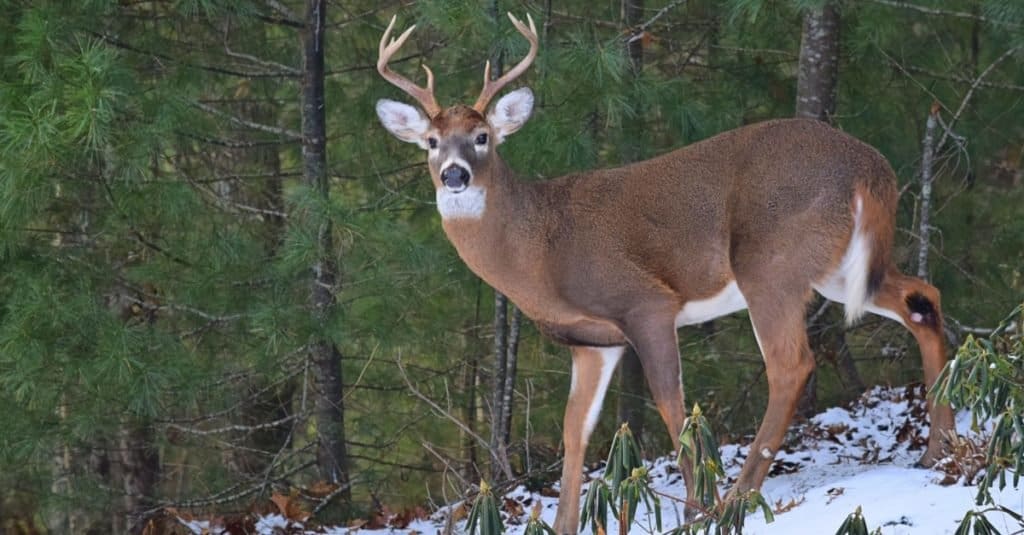
White-tailed deer
thrive in environments near rivers and streams.
©Michael Sean OLeary/Shutterstock.com
This medium-sized deer is native to North America and is widely distributed across the continent. This deer species is easily recognizable by the white underside of its tail, which it raises when predators are close. During the warmer months, it has a reddish-brown coat, but it changes to a grayish-brown in the fall and winter. Deer may not live in the water, but they prefer to inhabit areas near rivers and streams and thrive in environments with plenty of food, water, and shelter. They are almost entirely herbivorous and will eat legumes, plants, leaves, cacti, and even toxic mushrooms.
Red Fox
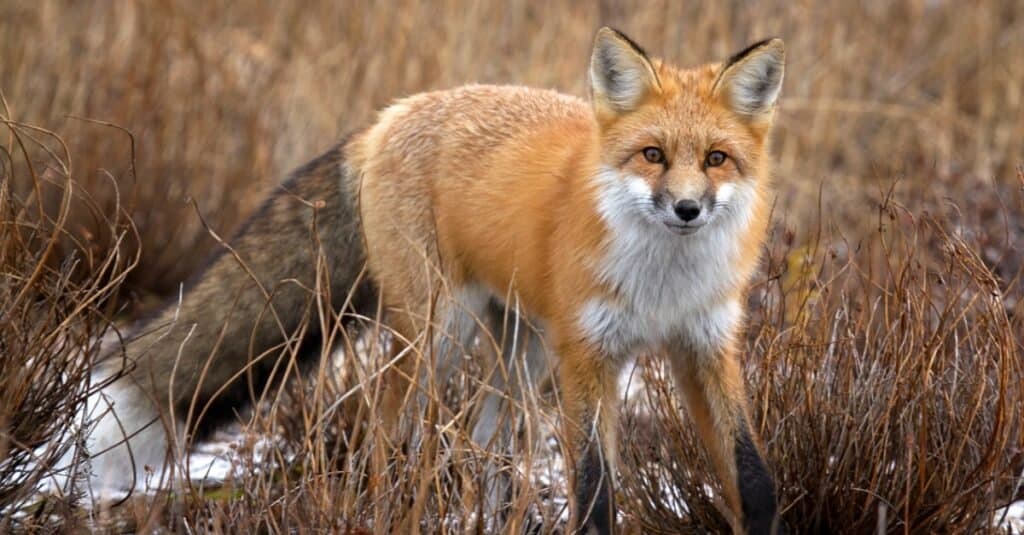
The red fox digs their burrow near the water with vegetation.
©iStock.com/Lynn_Bystrom
The red fox is widely distributed across the Northern hemisphere, including near the Mississippi River in North America. This fox species has an elongated body, short limbs, a long, bushy tail, and rusty red fur. They like to live in woodlands, brushy fields, and wetlands, and they dig their burrows near the water with plenty of vegetation for cover. Red foxes are omnivores and consume over 300 animal species and many plants. However, their main diet consists of small rodents like voles, mice, and squirrels (another reason they live next to rivers).
The photo featured at the top of this post is © iStock.com/Troy Levengood
Thank you for reading! Have some feedback for us? Contact the AZ Animals editorial team.






